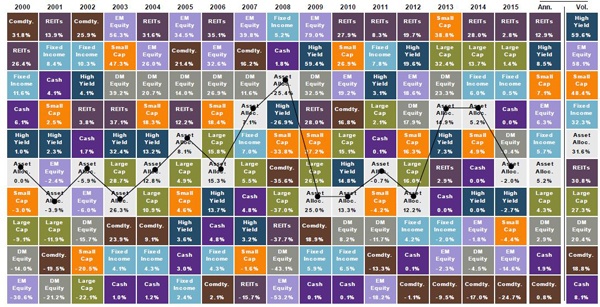The benefits of investment diversification have long been known, heralded, and applied to portfolio management. And that’s not likely to change going forward either – it seems highly unlikely that sometime in the future we’ll look back on diversification as some kind of antiquated investment tool that no longer works effectively.
That’s because asset prices have been volatile for as long as anyone can remember, and they move in all different directions at different times. While diversification and asset allocation do not ensure a profit or guarantee against loss, the theory of diversification that “everyone talks about” is if you own a portion of each asset class in your portfolio, you can attempt to neutralize the impact of individual price changes—smoothing out returns with lower volatility.
The Traditional Definition of Diversification
A closer look at the chart below helps bring the point home. In a year like 2013, for instance, the Small Cap category performed the best, but in 2014 it delivered much lower returns. Yet REITs did almost exactly the opposite! If an investor had exposure to both asset classes during both years, money invested in those areas would be poised to participate in the upside of the best performing category in both years.
Looking at the negative, consider the year 2002 when owning only Small Cap would have hurt returns and made for a disappointing year. However, if you owned REITs and some Fixed Income that year, you may not have felt such a drag on total returns. You can find examples like these in each year, where diversification can help potentially smooth out returns.
As you can see below, a more diversified portfolio from 2000 – 2014 delivered higher returns with lower risk (measured by Standard Deviation).
The Diversification Few People Talk About
It’s one thing to diversify your portfolio across different asset classes, but how do you know how to manage each asset class? In other words, how do you know which Small Cap stocks to own within the Small Cap portion of your portfolio? That’s where WrapManager believes there is another aspect to diversification that few people talk about.
We agree that diversifying your portfolio across different asset classes can be part of a sound investment plan that helps you manage risk. But why not take that a step further and make sure that each asset class you own is being managed by a money manager that specializes—and excels—within that category?
That is one of the main foundations of WrapManager’s approach. We continuously evaluate and seek out different types of money managers across different asset classes, and we try to choose professionals who are experienced, deliver consistent results over time, and outperform their peers on a regular basis. Those are the managers we want overseeing the individual asset classes for our client’s investment portfolios.
Want to Learn Who WrapManager is Recommending for a Particular Asset Class?
One of our Wealth Managers would be happy to discuss with you some of the various money managers we research and evaluate, and we can provide you information on them as well as help you compare them to your current manager. A simple phone call can get you all of this information, so just give us a ring at 1-800-541-7774 and we’ll be happy to help. Or, if you prefer, feel welcome to contact us here.
Sources:
1. JP Morgan Guide to the Markets
2. JP Morgan Guide to Retirement







